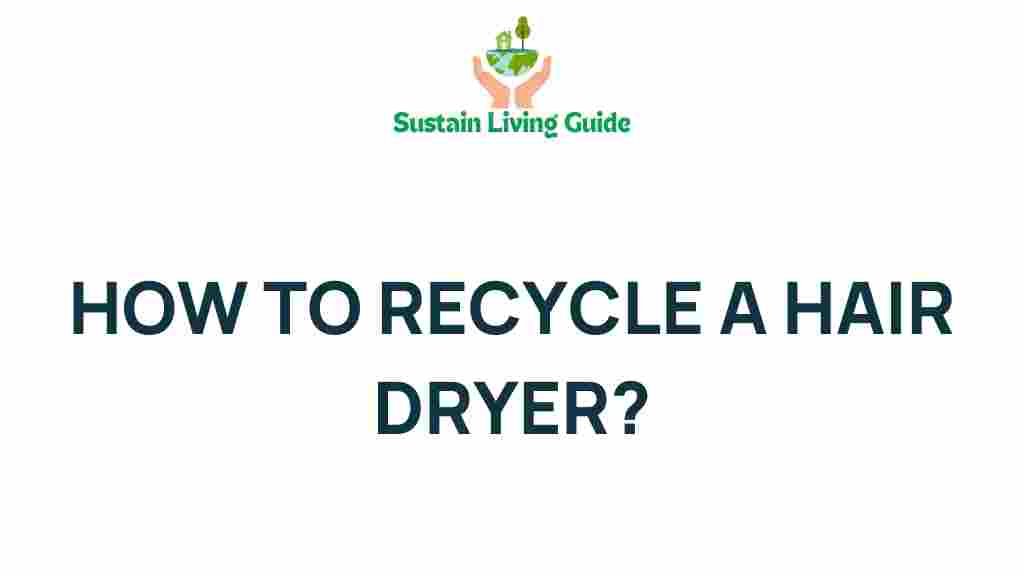Unlocking the Secrets: How to Recycle a Hair Dryer Sustainably
In today’s environmentally conscious world, the importance of sustainable practices cannot be overstated. One of the key areas where we can make a difference is in the recycling of household items, including electronics. Hair dryers, often overlooked, contribute to electronic waste (e-waste) when they reach the end of their life cycle. This article will guide you through the process of how to recycle a hair dryer sustainably, ensuring that your old appliance is disposed of responsibly and safely.
Why You Should Recycle Your Hair Dryer
Before diving into the step-by-step process of recycling your hair dryer, it’s essential to understand why recycling is crucial:
- Reduce E-Waste: Electronic waste is one of the fastest-growing waste streams. Recycling helps to reduce the amount of waste sent to landfills.
- Conserve Resources: Recycling allows the recovery of valuable materials, which can be used to make new products, reducing the need for raw materials.
- Protect the Environment: Proper recycling prevents harmful substances found in electronics from leaching into the soil and water.
- Support Sustainability: Participating in recycling initiatives supports a circular economy by promoting the reuse of materials.
How to Recycle Your Hair Dryer: A Step-by-Step Process
Recycling your hair dryer can be a straightforward process if you follow these simple steps:
Step 1: Assess the Condition of Your Hair Dryer
Before you decide to recycle, determine if your hair dryer can be repaired or donated. If it’s still functional, consider:
- Donating it to a local charity or shelter.
- Giving it to a friend or family member.
If the hair dryer is damaged beyond repair, it’s time to move on to recycling.
Step 2: Check for Local Recycling Programs
Many communities have specific recycling programs for electronics. Check with your local waste management authority or visit their website to find out about:
- Drop-off locations for e-waste.
- Scheduled e-waste collection events.
Step 3: Remove Non-Recyclable Parts
Before recycling, disassemble your hair dryer to remove non-recyclable components. This may include:
- Plastic casing
- Power cord
- Heating element
While some of these parts can be recycled, others may need to be thrown away. Always check your local guidelines for proper disposal.
Step 4: Recycle the Components
Once you’ve disassembled the hair dryer, take the recyclable parts to the appropriate recycling facility. Most facilities will accept:
- Metal components: These can often be recycled as scrap metal.
- Plastic parts: Check if your local recycling program accepts electronic plastic.
For non-recyclable parts, ensure they are disposed of according to local regulations.
Step 5: Explore Retailer Recycling Programs
Many electronics retailers offer recycling programs for old appliances, including hair dryers. Some popular retailers include:
- Best Buy
- Target
- Home Depot
Check their websites for specific guidelines on how to recycle your hair dryer through their programs.
Troubleshooting Tips for Recycling Your Hair Dryer
Sometimes, the recycling process can hit a few snags. Here are some common issues you may encounter and how to resolve them:
Issue 1: Difficulty Disassembling the Hair Dryer
If you’re having trouble taking your hair dryer apart, ensure you have the right tools. You may need:
- Screwdrivers (Phillips and flathead)
- Pliers
- Safety gloves
Issue 2: Not Sure Which Parts Are Recyclable
When in doubt, check with your local recycling facility. They can guide you on which materials are accepted.
Issue 3: Limited Local Recycling Options
If your area lacks recycling programs, consider mailing your hair dryer to a specialized e-waste recycling company. Many offer prepaid shipping labels for easy disposal.
Conclusion: A Sustainable Choice for Our Planet
By learning how to recycle your hair dryer sustainably, you are taking a significant step towards reducing e-waste and promoting environmental responsibility. Remember that every small action counts, and your efforts can lead to a healthier planet. Whether you decide to repair, donate, or recycle, know that you are making a positive impact.
For more information on recycling and sustainable practices, check out the EPA’s recycling page. Together, we can work towards a more sustainable future!
For further guidance on recycling other appliances, visit our recycling resources page.
This article is in the category Waste and created by SustainLivingGuide Team
